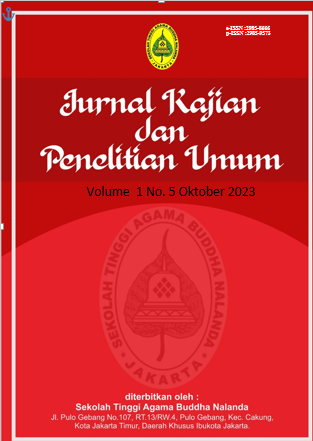Analisis Tekstual Dan Kontekstual Tari Batobo Di Kanagarian Piobang Kecamatan Payakumbuh Kabupaten 50 Kota
DOI:
https://doi.org/10.47861/jkpu-nalanda.v1i5.452Keywords:
Analysis, Textual, Contextual, Batobo DanceAbstract
This study aims to describe and analyze the textual and contextual analysis of Batobo Dance in Kanagarian Piobang, Payakumbuh District, 50 City Regency. This type of research is qualitative research with descriptive methods of analysis. This research instrument is the researcher himself and is assisted by supporting instruments such as stationery and cameras. Data were collected through literature study, observation, interviews and documentation. The steps of analyzing data are collecting data, describing the data and inferring the data. The results showed that Batobo Dance was analyzed based on textual and contextual analysis. The textual analysis of Batobo Dance is to describe batobo activities clearly and each community has a role in batobo. Male dancers do the work of hoeing the rice fields while female dancers do the movement of catching fish at times on the edge of the rice fields, also do planting movements, to rice manuai. While the contextual analysis of this dance has reflected a compact life in society, the spirit of gotong royong is strongly reflected in the energetic and happy movements of dancers. This activity is driven by niniak mamak, this activity basically aims to foster children and nieces and nephews in achieving unity and unity for common life, especially in cultivating rice fields or fields.
References
Amanda, A. P., & Nerosti, N. (2023). Bentuk Penyajian Tari Galombang Sanggar Umbuik Mudo dalam Pesta Perkawinan di Nagari Sungai Asam, Kabupaten Padang Pariaman. Jurnal Sendratasik, 12(1), 93-102.
Darmawati, D., & Susmiarti, S. (2013). Model Pengembangan Tari Luambek: dari Tradisi Lokal ke seni pertunjukan hiburan.
Desfiarni, D. (2004). Tari Luka Gilo: Sebagai Rekaman Budaya Minangkabau Praislam: dari Magis ke Seni Pertunjukan Sekuler (pp. 1-169). Kalika.
Indrayuda. (2012). Eksistensi Tari Minangkabau. Padang : UNP Press.
Moleong, Lexy J. (2012).Metodologi Penelitian Kualitatif. Bandung: PT Remaja. Rosdakarya.
Moleong, Lexy. J. (2010). Metodologi Penelitian Kualitatif. Bandung: Remaja Rosda karya.
Nerosti. (2021). Mencipta dan Menulis Skrip Tari. Depok: PT RajaGrafindo Persada
Setyawati, E. (2018).Rancang Bangun Software Tutorial Pengenalan Seni Tari Tradisional.Media Aplikom, 10(1), 47-68.
Supardjan. 1982. Pengantar Pengetahuan Tari 1. Jakarta: CV. Sandang Mas.
Surya, W. K., & Nerosti, N. (2021). Eksistensi Tari Andun Dalam Upacara Adat Perkawinan Di Kecamatan Seluma Kabupaten Seluma Provinsi Bengkulu. Jurnal Sendratasik, 10(4), 51-60.
Zulmaiza, S., & Nerosti, N. (2022). Bentuk Penyajian Tari Puti Bungo Api Sanggar Mandugo Ombak Di Kelurahan Ibuh, Kecamatan Payakumbuh Barat Kota Payakumbuh. Jurnal Sendratasik, 11(1), 58-66.
Downloads
Published
How to Cite
Issue
Section
License
Copyright (c) 2023 Sisi Ranita Yahya, Nerosti Nerosti

This work is licensed under a Creative Commons Attribution-ShareAlike 4.0 International License.








